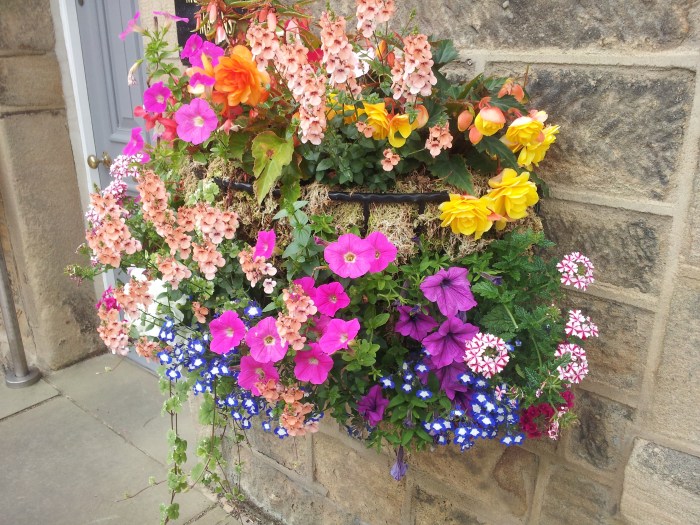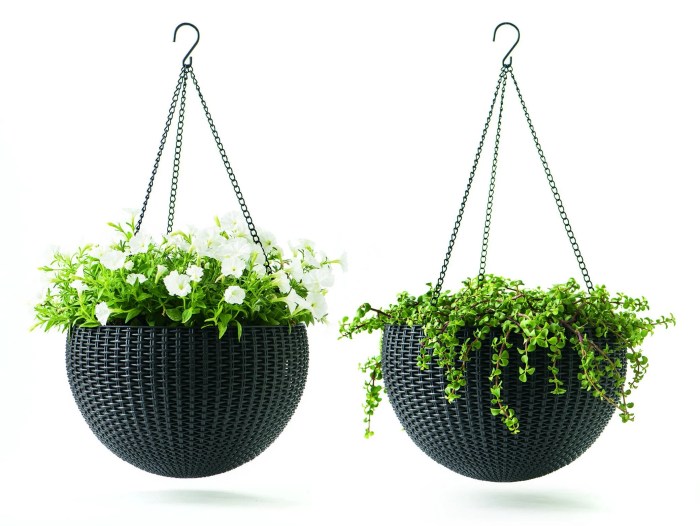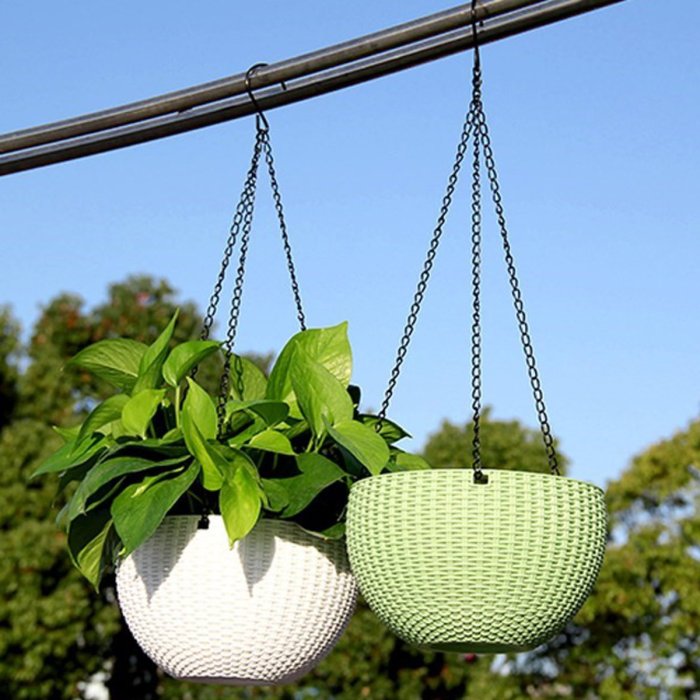Large indoor hanging baskets are a versatile and stylish way to add greenery and visual interest to your home. From macrame to metal and wicker, there are a variety of hanging basket types to choose from, each with its own advantages and disadvantages.
Whether you’re looking to create a lush indoor garden or simply add a touch of nature to your décor, large indoor hanging baskets are a great option.
When choosing plants for your hanging baskets, it’s important to consider factors such as light requirements, water needs, and growth habits. Some popular choices for indoor hanging baskets include ferns, succulents, and trailing plants. Once you’ve selected your plants, it’s time to design your hanging baskets.
Keep in mind the principles of balance, color, and texture to create a cohesive and visually appealing display.
Hanging Basket Types

Hanging baskets add a touch of greenery and style to any indoor space. They are available in a wide range of materials, styles, and sizes to suit any décor. Here are the main types of hanging baskets for indoor use:
Macrame Hanging Baskets
Macrame hanging baskets are made from woven cotton or jute cords. They are lightweight and airy, and they add a bohemian touch to any room. Macrame baskets are available in a variety of shapes and sizes, and they can be used to hold plants, flowers, or other decorative items.
Advantages:
- Lightweight and easy to hang
- Bohemian and stylish
- Versatile and can be used for a variety of purposes
Disadvantages:
- Not as durable as other types of hanging baskets
- Can be difficult to clean
Metal Hanging Baskets
Metal hanging baskets are made from wrought iron or aluminum. They are sturdy and durable, and they can be used to hold heavy plants or flowers. Metal baskets are available in a variety of finishes, including black, white, and copper.
They can be used to create a modern or industrial look.
Advantages:
- Sturdy and durable
- Can be used to hold heavy plants or flowers
- Available in a variety of finishes
Disadvantages:
- Can be heavy and difficult to hang
- Can rust if not properly cared for
Wicker Hanging Baskets
Wicker hanging baskets are made from woven willow or rattan. They are lightweight and durable, and they add a natural touch to any room. Wicker baskets are available in a variety of shapes and sizes, and they can be used to hold plants, flowers, or other decorative items.
Advantages:
- Lightweight and durable
- Natural and stylish
- Versatile and can be used for a variety of purposes
Disadvantages:
- Can be difficult to clean
- Can be damaged by water
Plant Selection for Hanging Baskets
When selecting plants for large indoor hanging baskets, it is essential to consider several factors, including light requirements, water needs, and growth habits. Choosing the right plants will ensure a vibrant and thriving display that enhances the ambiance of your indoor space.
Plants with varying light requirements can be accommodated in different locations within the room. For areas with ample natural light, plants like ferns, spider plants, and peace lilies thrive. In low-light conditions, snake plants, ZZ plants, and pothos are suitable choices.
Water Requirements
The frequency of watering depends on the specific plant species and the humidity levels in the room. Plants with low water needs, such as succulents and cacti, can tolerate infrequent watering. On the other hand, ferns and other moisture-loving plants require regular watering to maintain their lush foliage.
Growth Habits
Consider the growth habits of the plants when selecting them for hanging baskets. Trailing plants like ivy, pothos, and philodendron create a cascading effect, while upright plants like ferns and palms add height and structure to the arrangement.
- Ferns:Require indirect light and regular watering. Choose varieties like Boston fern or maidenhair fern for a lush and elegant look.
- Spider Plants:Tolerate a wide range of light conditions and produce arching foliage with spiderettes. Water when the soil feels dry to the touch.
- Peace Lilies:Prefer indirect light and moist soil. Their white blooms add a touch of elegance to any space.
- Snake Plants:Known for their hardiness and low water needs. Ideal for low-light areas and can tolerate infrequent watering.
- ZZ Plants:Another low-maintenance option that tolerates low light and infrequent watering. Their glossy foliage adds a touch of sophistication.
- Pothos:Trailing plants that thrive in indirect light and require moderate watering. Their variegated foliage adds color and interest.
- Ivy:A classic trailing plant that can tolerate a range of light conditions. Water when the soil surface feels dry.
- Philodendron:Another trailing plant with heart-shaped leaves. Prefers indirect light and moist soil.
Hanging Basket Design
Designing visually appealing and functional hanging baskets requires an understanding of the principles of balance, color, and texture. By incorporating these elements harmoniously, indoor hanging baskets can become captivating focal points within any space.
Balancein hanging basket design refers to the distribution of visual weight. Symmetrical arrangements, where plants are placed evenly on both sides, create a sense of stability and order. Asymmetrical designs, on the other hand, offer a more dynamic and informal look, with plants arranged in varying heights and positions to create visual interest.
Large indoor hanging baskets, often used to add a touch of greenery to living spaces, can be complemented by wall planters indoor . These wall planters offer a vertical solution for displaying plants, creating a lush and inviting atmosphere. By incorporating both large indoor hanging baskets and wall planters, homeowners can maximize their vertical space and bring nature indoors in a visually appealing way.
Color
Color plays a crucial role in enhancing the aesthetics of hanging baskets. Monochromatic schemes, featuring plants with similar hues, create a cohesive and elegant look. Complementary color combinations, such as blue and orange or red and green, generate a striking contrast that draws the eye.
Additionally, incorporating variegated foliage or flowers with contrasting colors adds depth and interest to the design.
Texture
Texture adds a tactile element to hanging baskets, creating visual depth and dimension. Smooth, glossy leaves contrast beautifully with rough, textured foliage, while delicate ferns and airy grasses provide a sense of lightness and movement. By combining plants with varying textures, designers can create a visually engaging and dynamic display.
Here are some tips for creating a cohesive design for indoor hanging baskets:
- Consider the size and shape of the basket when selecting plants. Overcrowding can lead to a cluttered and unappealing look.
- Use a variety of plant heights and forms to create a visually interesting arrangement. Taller plants can provide a dramatic backdrop, while trailing plants add a sense of movement and flow.
- Experiment with different color combinations to create a unique and eye-catching display. Consider the overall color scheme of the room when making your selections.
- Add texture to the design by incorporating plants with varying leaf shapes, sizes, and textures. This will add depth and interest to the arrangement.
Hanging Basket Care and Maintenance

Indoor hanging baskets require regular care and maintenance to thrive. Proper watering, fertilizing, and pruning are essential for their health and longevity. Regular inspection and pest control are also crucial to prevent issues.
Watering
Indoor hanging baskets require consistent watering, but overwatering should be avoided. The frequency of watering depends on the type of plants, the size of the basket, and the environmental conditions. Generally, water when the soil surface feels slightly dry to the touch.
Use lukewarm water and avoid getting the foliage wet.
Fertilizing, Large indoor hanging baskets
Fertilize hanging baskets regularly during the growing season, usually from spring to fall. Use a balanced liquid fertilizer diluted to half strength and apply it according to the manufacturer’s instructions. Avoid over-fertilizing, as it can damage the plants.
For those seeking to add a touch of greenery to their indoor spaces, large indoor hanging baskets offer a stylish and practical solution. These versatile containers can be suspended from ceilings or walls, providing ample space for lush plants and trailing vines.
Wall pots indoor offer a similar solution , allowing you to create a living wall display. With their ability to accommodate a variety of plant species, large indoor hanging baskets bring a touch of nature and freshness to any room.
Pruning
Regular pruning helps maintain the shape and size of hanging baskets. Remove dead or damaged leaves and stems promptly. Trim back overgrown plants to encourage new growth. Pruning also helps improve air circulation and light penetration.
Inspection and Pest Control
Inspect hanging baskets regularly for pests or diseases. Treat any infestations promptly with appropriate pesticides or fungicides. Remove infected plants if necessary to prevent the spread of disease. Use neem oil or insecticidal soap for organic pest control.
Creative Uses for Hanging Baskets

Beyond their traditional use for displaying plants, large indoor hanging baskets offer a wealth of creative possibilities. These versatile containers can be transformed into unique and functional pieces, adding a touch of style and functionality to any space.
Storage Solutions
Hanging baskets can provide ample storage for various items, freeing up valuable floor space. Consider using them to organize toys, blankets, pillows, or even kitchen utensils. Choose baskets with sturdy construction and breathable materials to ensure durability and prevent moisture accumulation.
Illuminating Accents
Hanging baskets can be transformed into elegant lighting fixtures. By installing LED lights or candles inside, you can create ambient or accent lighting that enhances the atmosphere of a room. Suspend the baskets at different heights to create a layered effect and add depth to the space.
Decorative Display
Hanging baskets can serve as eye-catching decorative elements. Fill them with artificial flowers, fairy lights, or seasonal decorations to create a festive or whimsical touch. Alternatively, use them to display artwork, photographs, or other collectibles, adding a personal touch to your décor.
Outcome Summary
With proper care and maintenance, your large indoor hanging baskets will thrive for years to come. Be sure to water and fertilize your plants regularly, and prune them as needed to maintain their shape and size. Regular inspection and pest control will also help to keep your hanging baskets healthy and looking their best.
Answers to Common Questions: Large Indoor Hanging Baskets
How often should I water my hanging baskets?
The frequency of watering will depend on the type of plants you have in your hanging baskets, as well as the humidity and temperature of your home. As a general rule, you should water your hanging baskets when the soil feels dry to the touch.
What is the best way to fertilize my hanging baskets?
You can fertilize your hanging baskets with a balanced liquid fertilizer every two to four weeks during the growing season. Be sure to follow the instructions on the fertilizer label.
How can I prevent pests from damaging my hanging baskets?
Regularly inspect your hanging baskets for pests, and treat them as needed with an appropriate pesticide. You can also help to prevent pests by keeping your hanging baskets clean and free of debris.